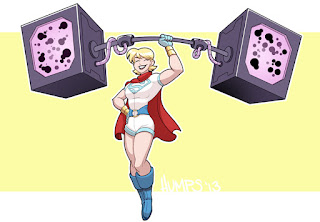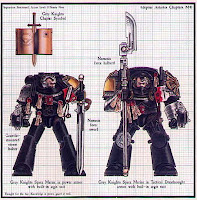Every business has its icons. From the Caped Crusader to the First Avenger, DC Comics and Marvel have had no end of their famous heroes, with histories stretching back to their foundation. Often considered the modern myths, any child who grew up watching their animated outings in the 90s, or the live action golden age we now live in, knows their names. They know their powers, they know what they stand for, the know just why they're heroic. Even among the smaller companies like the sadly long lost Wildstorm or the independent comics of Dark Horse's publications you have the likes of Midnighter and Hellboy. Yet, there are others besides them, characters who represent their own facets of this world or their own ideals, sadly overshadowed by giants. Today we're going to talk about one and why, I personally, rank her as one of the best among DC Comics' superheroes.
Now, i'll freely admit some of what I am going to say here will echo statements by others within the fandom. This isn't a wholly original view of the character and I have heard of much the same said by followers here and there. As such, you might hear the same general points cited but I am going to try and put my own spin on them and cite why I feel they matter due to her place in the universe, at least through my eyes.
So, who is Power Girl? Simply put - Another surviving kryptonian by the name of Kara Zor-L, specifically Superman's cousin. Like the surprisingly large number of other survivors, she was sent to Earth and grew up there becoming one of its defenders. However, that's where things become a little complicated. You see, she's also originally from an alternate Earth, one which took place far into the future when compared with the existing timeline. Both in the old setting and New 52, that world was destroyed, stranding her in the main DC Universe, surrounded by semi-familiar faces. Yes, that is the simple version.
Now, some of you are already thinking one thing: The reason I favour her is down to the costume. Well, no, not really. In all honesty, while I personally do like the colour balance and general design, i'm not averse to large scale changes either. Despite an overabundance of red and a lack of blue, her New 52 outfit actually grew on me, and my all-time favourite design was a fan creation -
Equally, while she's intended to be an attractive character, she works best with art which can balance humanity and humour with sexiness; all without pushing completely into objectification or losing any aspect entirely when focusing upon one over the others. It's a major reason why Amanda Conner is considered to be the definitive artist for the character, as she can more easily balance these elements than anyone else.
 Instead, the foremost aspect which stands out above all else is how she can stand out as a complex person, and retain a more human aspect than Superman. There's the old argument that DC's characters made for better icons than relatable figures, and while debatable there is some truth to this. The average person sees him more as a figurehead than an everyman, even after all this time, and that can create a general disconnect with a reader in the wrong mindset. It's partially why the 90s boomed with so many anti-heroes crawling out of the woodwork, as a direct response to the seemingly incorruptible heroes of the world. It's also why, even today, you will find people arguing that the likes of Batman, the Question or even Apollo are better, because for all their abilities they are more distinctly "human" in their stories.
Instead, the foremost aspect which stands out above all else is how she can stand out as a complex person, and retain a more human aspect than Superman. There's the old argument that DC's characters made for better icons than relatable figures, and while debatable there is some truth to this. The average person sees him more as a figurehead than an everyman, even after all this time, and that can create a general disconnect with a reader in the wrong mindset. It's partially why the 90s boomed with so many anti-heroes crawling out of the woodwork, as a direct response to the seemingly incorruptible heroes of the world. It's also why, even today, you will find people arguing that the likes of Batman, the Question or even Apollo are better, because for all their abilities they are more distinctly "human" in their stories.Superman has the weight of the world constantly on his shoulders, and must constantly strive to be the symbol the world needs him to be. Writers feel they need to show him fighting against world-ending threats, alien gods, or full-fledged invasions to emphasis that power, all without him ever truly losing control. Because she lacks that same responsibility or view from the public, Power Girl had more freedom to act as almost an everyperson with Superman's powers. Yeah, that sounds like a bizarre oxymoron, but her dialogue and reactions were often far more human than that of Superman. They permitted far more opportunities for her to cut loose, be crass or even openly facepalm at some of her more ridiculous stories. She was also known as something of a combat enthusiast in the comics, and was more willing to freely use her powers without restraint, but never lost sight of keeping civilians safe. As such, writers never had her crossing the line of leveling most of Metropolis in an airborne fistfight, but they were quite happy to add awesome moments like this:
In addition to a broader range of story opportunities, that same lack of perpetually-doomsday-stopping responsibility was later embraced by writers to add some variety to the setting. Breaking from the typical comicbook formula, readers didn't end up with the expected five issues of "NOTHING WILL BE THE SAME AGAIN!" followed by a fight against a near unstoppable foe; something which was good in small doses, but DC and Marvel had been doing this for every damn comic for years on end by this point. Instead, Power Girl's comic focused more upon her day to day life as much as anything else. Aliens would show up to fight her, invasions would happen and there would be brawls, but there were lulls between that. There were long periods of humourous exchanges with her sidekick Terra, moments of running her business, or even running into some science fiction wackiness.
As strange as it sounds, seeing her stopping just to talk for a while with Doctor Mid-Nite and making fun of the usual supervillain tropes was refreshing. It was a moment to show them as people and concentrate upon their character dynamic rather than some desperate situation; thus giving a better sense of their long-standing friendship or existence in this world. This sort of dynamic would also carry over into World's Finest and apparently even influence the Supergirl television series to a lesser degree. While the writers in each case didn't quite nail it as well as their predecessors, its lighthearted nature nevertheless lit the way for those shows to follow, and helped break up the monotony of the ultra-serious grimdark porn superhero comics had been devolving into. Hell, if you want another series that followed the same sort of tone to an even greater effect, you need only look at One Punch Man and its willingness to balance fights with everyday life and humour.
Still, there is one key aspect above all others that makes Power Girl a personal favourite among my pantheon of comics characters. One key thing which truly elevated her above all other kryptonians and even major members of the Justice League:
She beat Superman at his own game.
Today, Superman is best known as an American icon. "Truth, Justice, Freedom and the American way" is his famed tagline after all, and he is considered to be a key part of their culture. However, that was not always the case. Originally, Superman's life was supposed to emulate that of a migrant arriving in America and making his own way in the world. Like so many of those arriving to its shores, he was supposed to stand up as someone who had arrived as an alien but managed to find success there. This message has been lost over the years, unfortunately, and it seems Power Girl has stepped into his place. No matter the setting or continuity, she is always presented as a new arrival and has embraced this aspect of her life.
The whole "stranger in a strange land" idea is something which has been often done in Marvel, but in DC it fell by the wayside. Even the likes of Wonder Woman and Martian Manhunter quickly integrated themselves into society, and in the New 52 it's an aspect of Aquaman which has been surprisingly downplayed. With Power Girl, we ended up with a number of excellent - and some admittedly quite awful - story arcs exploring her identity, adjusting to an entirely new world, and learning to live with it. The comics even went one better than that later on, showing her starting to thrive there, both as a hero and via her secret identity.
In a surprising stunt we've rarely seen outside of Wildstorm, Justin Gray and Jimmy Palmiotti opted to take full advantage of her access to advanced kryptonian sciences. Taking up the name Karen Starr and establishing the company Starrware Industries, she took to building a small empire devoted to furthering advanced technology. While she wasn't about to transform the world overnight, Power Girl largely kept to Superman's ideals of letting humanity strengthen itself, she wasn't above giving it a slight nudge in the right direction. While it was often kept to the background, we did see the impact of this over time, with nanomachines, ideas and scientific breakthroughs arising both in and out of the comics in background events. It was at least enough to emphasize her success despite being an outsider.
There are undoubtedly others who have written more about the character, and in far greater detail, but this ultimately summarises my personal thoughts on the character. While there might be those with greater stories out there, those with more fabled writers, Power Girl nevertheless occupies a very underrated portion of the DC Universe. Perhaps one day we might see her gaining a little more attention before this golden age ends.


























